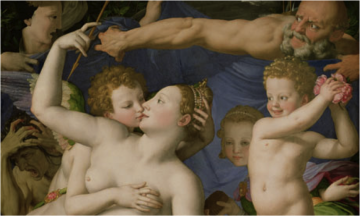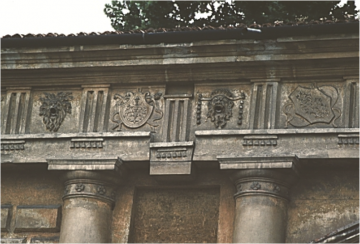It’s good, useless fun to pre-emptively define the times you live in. Nicholas Bourriaud’s confusingly limned term “Altermodern,” used to define works in last year’s Tate Triennial and, by extension, contemporary society as a whole, dropped out of parlance as soon as we got used to its pronunciation. Charles Saatchi’s 1999 show, New Neurotic Realism – a compendium of mainly loose-limbed realist painting, including Cecily Brown, Martin Moloney, and Dexter Dalwood – was an unsuccessful attempt at drawing the line under the YBAs. Even Rauschenberg’s and Johns’s “Neo-Dada” back in the late-50s had a lame-duck ring about it. It’s not only our era that has found its unique identity nigh-impossible to define, although the teeth-grinding muddling over “aughts” and “aughties,” “naughts” and “naughties” is perhaps the one thing that is definitively of our time: an anxiety over what our era is actually defined by. (Imagine a “naughts” or “naughties” theme party – well, you won’t have to for long – and you get the picture). Art writers suffer from pre-emptive epochal-definition disorder almost as much as music writers do (remember the New Wave of New Wave? No?), but something particular has entered the argument recently — an attempt to define today’s art in reference to the art of the past, in particular, to the art of Mannerism.
Mannerism is the only pre-Impressionist “movement” that’s meant as an insult. Loosely defined as the stretch of time between the summit of the High Renaissance and the beginnings of the Baroque in the late 1500s, it describes an art of high style (“maniera,” in Italian) and convoluted reference best exemplified in the paintings of Pontormo, Bronzino, and Parmigianino, the sculptures of Giambologna and Cellini, and the buildings of Michaelangelo and Giulio Romano. Its origins as a term are contested, but it seems to have first been used in the modern sense by 17th century theorist Gianpietro Bellori. As John Shearman summarizes it, for Bellori, mannerism “was an ideal born in the artist’s fantasy and based not upon reality but upon pratica: stylistic convention and technical expertise.” A Mannerist audience might bust a gut at Romano’s wonky architraves at the Palazzo del Te, or titter and blush at Bronzino’s filthy Venus and Cupid, or fawn admiringly over Cellini’s camp-as-Christmas salt cellar. It’s an art aimed squarely at Renaissance cognoscenti, full of winking allusion and pictorial trickery. Picture a cross between Raphael and David Copperfield and you’ve more or less got it.
And now this: “Mannerism, the most commonly despised period in Western art history…[is] the one that best befits creative culture today. We are mostly Mannerists now…” That’s Peter Schjeldahl, reviewing the new exhibition of Bronzino’s drawings at the Met. Jerry Saltz, writing in New York magazine, calls Bronzino, “sixteenth-century Italy’s Joey Ramone” (he’s wrong: Bronzino was sixteenth-century Italy’s Peter Gabriel, but you get his point). Kay Larson, writing a few years back in ArtNews, provided a tautological definition of some contemporary art as “postmodern mannerism” (Mannerism is by definition a postmodern practice, in everything but date). She quotes curator Norman Kleeblatt of the Jewish Museum: “When I look at classic Mannerist art, there is such playfulness…I think that is the connection with contemporary art.”
Whether or not you take this enthusiastic rebranding as insult or accolade depends entirely on your attitude to the term. Writing in The Guardian, Jonathan Jones bemoans the wholesale claiming of the term “modern” to cover contemporary art (something enshrined in the public mind by the sneakily-named Tate Modern, which is mainly contemporary in content). His allusion is to Mannerism too, but unlike Saltz and Schjeldahl, it’s not a compliment:
And this is the problem that dogs the art critic in the 21st century. Our glibly high evaluation of today’s art, casually calling it “modern art” as if it could ride roughshod over the achievements of the last century, and we could cherry pick modernism’s history to find phoney lineages for whatever we want to plug, is a massive lie. The arts in the period between 1880 and 1920 reached heights of achievement unseen since the Renaissance. The avant-garde in its prime was all greatness, all glory. With the best will in the world, and however much we find to admire and to hope for, our time is mannerist in comparison.
The Mannerist tendency in contemporary art (though rarely named as such) is the one agreed-upon quality that unites champions and skeptics alike. It’s what we hate or love about art now. We can agree that much contemporary art relies upon a fairly comprehensive understanding not only of art history but also of what’s trendy in contemporary theory. You don’t “get” contemporary museum darlings Pierre Huyghe, Thomas Hircshhorn, Dan Graham, or Roni Horn without some idea of what currents of thought they draw from. It’s the same principle as (say) Giulio Romano’s architectural whimsy, which only a viewer with a thorough knowledge of the tropes of classical architecture will be able to “get.” It’s this quality that makes work of this kind appealing to academics and off-puttingly esoteric to the unschooled visitor — the same reaction Mannerism itself might have had in its period. Mannerism is in part designed to flatter the cultural sophistication of the patron, a kind of aesthetic flirtation, which might also be said for institutionally subsidized contemporary art (especially that known as “institutional critique”), which indulges in a bit of mutually beneficial benign teasing. Visual sampling from art of the past, again flatteringly reliant upon the cultural savvy of its viewership, is a trait of Mannerism also prevalent in contemporary practice. Works by Sherrie Levine, Sturtevant, Vik Muniz, or Glenn Brown depend utterly upon a viewer’s grasp of art history and museology. Similarly, Bronzino’s citations of Michaelangelo and Hellenistic sculpture rely upon an encyclopedic artistic knowledge to be seen as they really are: ravishing collages of nods and winks.
It’s prescient but coincidental that Michael Landy’s installation, Art Bin, is on display at the South London Gallery at the moment. Landy has placed a huge, transparent-walled enclosure in the gallery in what he calls “a monument to creative failure”; the public is invited to submit works of art to the gallery, which will be dumped into the bin and destroyed (a Damien Hirst diamond skull print was one of the first). Aside from its obvious allusions to Gustav Metzger’s Auto-Destructive Art of the 1960s, what’s called to mind is the public destruction of works of art during the Renaissance, at the end of what might be thought of as Mannerism mark one. Dominican cleric Savonarola’s bonfire in the Piazza della Signoria in Florence in 1497 involved the wholesale destruction of books, furniture and works of art he saw as morally perverse. A possibly apocryphal tale has Botticelli, arch pre-Mannerist painter of patronal flattery and nodding allusion, tossing his own work into the flames. We think of this sort of act as horrifying, a distressing precursor of Nazi book-burning, yet its return in Landy’s installation might give us necessary pause. Is the art of our time doomed to dwindle as a footnote to something greater, as Mannerism has to the Renaissance? “You can’t compete with perfection,” claims Saltz; Schjeldahl suggests otherwise:
The old verdicts [conventional disdain of Mannerist art by art historians] suggest a proactive condemnation – of our own era – which, for all we know, future generations may come to endorse. Meanwhile, we are doing the best we can in the twenty-first century, things being as they are; and anyone who wants our friendship had better be civil to Bronzino.







Pingback: What’s Cookin at the Art21 Blog: A Weekly Index | Art21 Blog